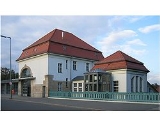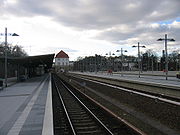
Berlin Olympiastadion railway station
Encyclopedia
Olympiastadion is a railway station in the Westend
district of Berlin
. Located at the southern entrance of the Olympic Stadium
, it is served by the S-Bahn
lines and , and other lines (especially the ) are extended to the station during major events. The station consists of one island platform
which is in regular use, as well as four further terminal island platforms which are only used for the extra trains during major events.
 The station opened in 1909 on the Westbahn suburban railway north of the Grunewald
The station opened in 1909 on the Westbahn suburban railway north of the Grunewald
forest. It was then called Rennbahn after a horse racing
circuit at the site of the today's stadium. Like the nearby U-Bahn station
it received the name Stadion in 1913, when the Deutsches Stadion
, projected for the 1916 Summer Olympics
, was inaugurated. After Berlin was awarded the 1936 Summer Olympics
the station was again renamed Reichssportfeld until it got its actual designation in 1960, spelled without a hyphen in contrast to the Olympia-Stadion U-Bahn station. Adjacent to the south is the Berlin Unité d'Habitation
, erected in 1958 according to plans by Le Corbusier
.
Westend (Berlin)
Westend is a locality of the Berlin borough Charlottenburg-Wilmersdorf situated on the Spandauer Berg, the northern peak of the Teltow plateau between the river valleys of Spree and Havel...
district of Berlin
Berlin
Berlin is the capital city of Germany and is one of the 16 states of Germany. With a population of 3.45 million people, Berlin is Germany's largest city. It is the second most populous city proper and the seventh most populous urban area in the European Union...
. Located at the southern entrance of the Olympic Stadium
Olympic Stadium (Berlin)
The Olympiastadion is a sports stadium in Berlin, Germany. There have been two stadiums on the site: the present facility, and one that is called the Deutsches Stadion which was built for the aborted 1916 Summer Olympics. Both were designed by members of the same family, the first by Otto March...
, it is served by the S-Bahn
Berlin S-Bahn
The Berlin S-Bahn is a rapid transit system in and around Berlin, the capital city of Germany. It consists of 15 lines and is integrated with the mostly underground U-Bahn to form the backbone of Berlin's rapid transport system...
lines and , and other lines (especially the ) are extended to the station during major events. The station consists of one island platform
Island platform
An island platform is a station layout arrangement where a single platform is positioned between two tracks within a railway station, tram stop or transitway interchange...
which is in regular use, as well as four further terminal island platforms which are only used for the extra trains during major events.

Grunewald
Grunewald is a locality within the Berliner borough of Charlottenburg-Wilmersdorf. Famous for the homonymous forest, until 2001 administrative reform it was part of the former district of Wilmersdorf.-Geography:The locality is situated in the western side of the city and is separated from...
forest. It was then called Rennbahn after a horse racing
Horse racing
Horse racing is an equestrian sport that has a long history. Archaeological records indicate that horse racing occurred in ancient Babylon, Syria, and Egypt. Both chariot and mounted horse racing were events in the ancient Greek Olympics by 648 BC...
circuit at the site of the today's stadium. Like the nearby U-Bahn station
Olympia-Stadion (Berlin U-Bahn)
Olympia-Stadion is a Berlin U-Bahn station located on the line in the Westend district. It serves Berlin's Olympic Stadium, where football matches and other events are regularly held...
it received the name Stadion in 1913, when the Deutsches Stadion
Deutsches Stadion (Berlin)
Deutsches Stadion was a multi-use stadium in Berlin, Germany. It was initially used as the stadium of German football championship matches. It was replaced by the current Olympic Stadium in 1936. The capacity of the stadium was 64,000 spectators. Located in the Grunewald Race Course was due to...
, projected for the 1916 Summer Olympics
1916 Summer Olympics
The anticipated 1916 Summer Olympics, which were to be officially known as the Games of the VI Olympiad, were to have been held in Berlin, Germany. However, due to the outbreak of World War I, the games were cancelled.-History:...
, was inaugurated. After Berlin was awarded the 1936 Summer Olympics
1936 Summer Olympics
The 1936 Summer Olympics, officially known as the Games of the XI Olympiad, was an international multi-sport event which was held in 1936 in Berlin, Germany. Berlin won the bid to host the Games over Barcelona, Spain on April 26, 1931, at the 29th IOC Session in Barcelona...
the station was again renamed Reichssportfeld until it got its actual designation in 1960, spelled without a hyphen in contrast to the Olympia-Stadion U-Bahn station. Adjacent to the south is the Berlin Unité d'Habitation
Unité d'Habitation
The Unité d'Habitation is the name of a modernist residential housing design principle developed by Le Corbusier, with the collaboration of painter-architect Nadir Afonso...
, erected in 1958 according to plans by Le Corbusier
Le Corbusier
Charles-Édouard Jeanneret, better known as Le Corbusier , was a Swiss-born French architect, designer, urbanist, writer and painter, famous for being one of the pioneers of what now is called modern architecture. He was born in Switzerland and became a French citizen in 1930...
.

